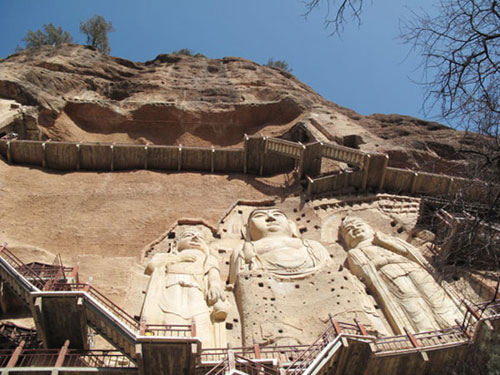
Three Buddha statues carved on the cliff surface are the highlights of Maiji's Buddhist heritage. (China Daily/Li Yang)
This is the wisdom of ancient artists. They were good at making use of natural light and imagination to bring life to a still face.
Buddhism came to China through the Hexi Corridor along the Yellow River in Gansu province about 1,600 years ago, when ethnic groups from the north and the west came to central China in large migrations.
The religion born in India has gone to southeast and northeast Asia from China, despite its ups and downs.
The most popular Buddha is Amitabha, who is believed to be the chief Buddha of the Pure Land sect. Amitabha empowers all calling upon him to be reborn into his world, the Pure Land, where they receive all kinds of instruction by him and become bodhisattvas and Buddhas later.
This is the most prevalent school of Mahayana Buddhism during the first stage of Buddhism evangelization in China, when the three main Buddha statutes of Maiji Mountain were made.
There are many big holes beside the huge grotto of the three great statues, about 0.5 meters in diameter and about 1 meter deep.
It is said ancient workers first dug these holes and inserted solid tree trunks to form various working platforms, like scaffolds. The holes were also used by repairmen and painters in later times to construct their working platforms.
The climb up the stairs, passing by the great statues, felt like a walk through a museum.
On the cliff surface 50 to 70 meters above the mountain foot are scattered about 194 caves with more than 7,200 pieces of Buddha sculptures and more than 1,000 square meters of frescos remain on the inner surface of the caves.
The most common pattern of the sculptures consists of a Buddha, sitting or standing, flanked by bodhisattvas and other attendants, or by monks or lay worshippers. The bodhisattvas on the Buddha's right are usually Avalokitesvara, and Mahasthamaprapta are on the Buddha's left. Pairs of dvarapala (gate guardian) or the four Heavenly Kings stand near the doorways to guard the Buddha and his entourage.
Some of the statues are as big as 5 to 6 meters tall and the caves they rest in are meters deep into the cliff. Some are only 50 to 60 centimeters tall and the caves are only as big as old-fashioned TV sets.
Some caves are lined up in good order with dozens or even hundreds of statues sculptured in the same fashion.
Although most of the paint has faded away, visitors can still verify their exquisite expressions on the face, each one different from another.
